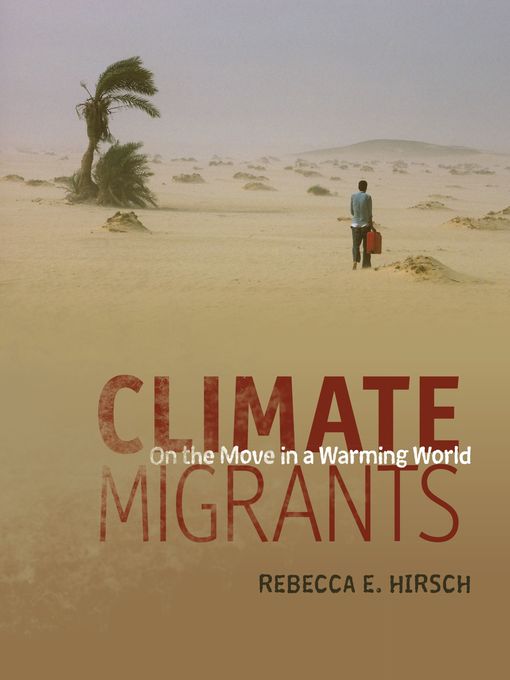-
Creators
-
Publisher
-
Release date
August 1, 2016 -
Formats
-
Kindle Book
-
OverDrive Read
- ISBN: 9781512420838
-
PDF ebook
- ISBN: 9781512411454
- File size: 9121 KB
-
-
Languages
- English
-
Levels
- ATOS Level: 8.3
- Lexile® Measure: 1230
- Interest Level: 4-8(MG)
- Text Difficulty: 7
-
Reviews
-
School Library Journal
August 1, 2016
Gr 7 Up-Hirsch reveals how climate change can directly impact human populations on lands currently undergoing environment-related transformations. Hirsch argues that millions are displaced by natural disasters each year and this number will continue to grow owing to rising ocean levels, droughts, melting permafrost, and other environmental changes caused by the effects of global warming. The result of these changes will eventually lead to mass migrations. While climate change is not reversible, Hirsch's outlook is not all gloom and doom. World leaders have the potential to take measures to curb carbon emissions and prepare for an influx of people in need of new homes. This is a well-researched study of an important issue, with full-color photographs, maps, graphs, and charts. The book is broken into five sections, each of which addresses a different aspect of the crisis. The final chapter also presents a future of climate change and climate migration. VERDICT A fitting addition to a classroom or school library. This thorough volume will be useful for reports and discussions on the intersection of environmental and social problems.-Kevin McGuire, Woodland Hills School District, PA
Copyright 2016 School Library Journal, LLC Used with permission.
-
Kirkus
July 15, 2016
A sober warning that climate change will become impossible to deny or ignore in the coming decades as mass population centers are rendered uninhabitable and the relocation of millions of people becomes inevitable. Relocation due to climate change is already a reality. Hirsch looks at the examples of Native Alaskan villages in Alaska, the Pacific island nation of Kiribati, and the Sahel region in central Africa. Droughts, desertification, rising sea levels, severe storms, and melting permafrost, all directly caused by climate change, are threatening communities of all sizes as well as entire nations. By 2050, at least 25 million people will be driven from their homes. Hirsch examines the immense logistical challenges and economic costs of relocating so many people, the consequences for communities whose cultural identities are geographically linked, and further environmental damage that will result from these mass migrations. She acknowledges that climate change cannot be stopped altogether but stresses that the consequences can be less catastrophic if nations take immediate steps to curb carbon dioxide emissions and initiate changes enabling communities to withstand climate-related damages and stresses. An accessible, informative, and alarming look at imminent, likely inevitable environmental catastrophes on a global scale. (maps, photos, glossary, source notes, bibliography, further information) (Nonfiction. 12-16)COPYRIGHT(2016) Kirkus Reviews, ALL RIGHTS RESERVED.
-
Booklist
October 1, 2016
Grades 9-12 In straightforward if occasionally dense prose accompanied by well-chosen charts, graphs, maps, and photos, Hirsch addresses a range of topics, including the factors leading to climate change and how climate changerelated disasters, such as wildfires, droughts, and floods, can lead not only to decimated landscapes but crop failures, depleted food sources, and population displacement. Throughout, she highlights individual locations, communities, and personal stories, from post-Katrina New Orleans to an Alaskan village permanently altered by arctic ice melt, thereby illuminating the challenges and consequences of climate change and personalizing the global phenomenon, emotionally and economically. Hirsch also covers current and potential plans to combat climate change, including using renewable energy resources, like wind power, and local efforts, such as a farmer in Africa practicing agroforestry. There's a wealth of information here, and while it's occasionally overwhelming, Hirsch clearly explains the scientific concepts at work in a thought-provoking way. Ideal for research projects, this is a striking look at a very timely topic.(Reprinted with permission of Booklist, copyright 2016, American Library Association.)
-
subjects
Languages
- English
Levels
- ATOS Level:8.3
- Lexile® Measure:1230
- Interest Level:4-8(MG)
- Text Difficulty:7
Loading
Why is availability limited?
×Availability can change throughout the month based on the library's budget. You can still place a hold on the title, and your hold will be automatically filled as soon as the title is available again.
The Kindle Book format for this title is not supported on:
×- - Kindle 1
- - Kindle 2
- - Kindle DX
- - Kindle Keyboard
- - Kindle 4
- - Kindle Touch
- - Kindle 5
- - Kindle Paperwhite
- - Kindle 7
- - Kindle Voyage
Read-along ebook
×The OverDrive Read format of this ebook has professional narration that plays while you read in your browser. Learn more here.



